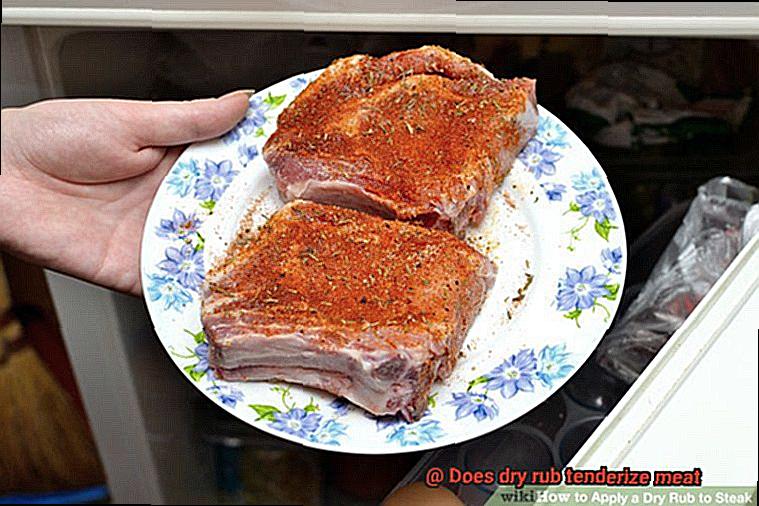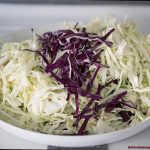Are you a self-proclaimed meat aficionado who loves experimenting with different cooking techniques? Do you often find yourself pondering whether a dry rub can truly work its magic and tenderize your meat? If the answer is yes, then you’re in for a treat. In this blog post, we’ll be unraveling the mystery behind whether or not dry rubs have the power to turn tough cuts of meat into melt-in-your-mouth goodness.
Before we dive into the nitty-gritty, let’s first establish what exactly a dry rub is. Essentially, it’s a blend of herbs and spices that are massaged onto raw meat before cooking. Dry rubs are popular for adding flavor to meats and creating a crispy crust on the exterior.
But here’s the million-dollar question: can a dry rub really make your meat more tender? Some swear by it, while others remain skeptical. We’ll be putting our lab coats on and delving into the science behind meat tenderization, as well as examining whether common dry rub ingredients have any impact on the process.
So get ready to embark on an adventure through the world of meat rubs. Along the way, we’ll be debunking some myths and sharing key takeaways about how to best utilize dry rubs in your cooking. Are you excited? Let’s get started.
Contents
Does a Dry Rub Tenderize Meat?
These flavor-packed blends of herbs, spices, and sometimes sugar are applied to the surface of meat before cooking to create a tantalizing crust and enhance its overall taste. But can they tenderize meat? Let’s delve deeper into this question.
While dry rubs do not technically tenderize meat on their own, they do contain enzymes that can help break down some of the connective tissues in the meat, making it more tender. Additionally, dry rubs often contain salt, which is excellent at drawing out moisture from the meat and breaking down tougher fibers.
However, it’s important to note that a dry rub cannot completely tenderize tough cuts of meat on its own. If you want truly tender meat, you’ll need to use a dry rub in conjunction with other methods such as marinating or slow cooking.
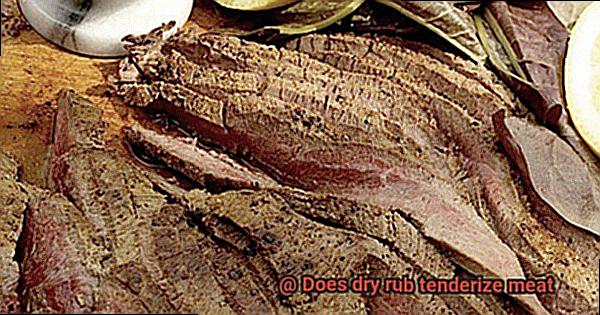
Marinating involves soaking the meat in an acidic liquid like vinegar or citrus juice for several hours before cooking. This helps break down the connective tissues in the meat and makes it more tender. A slow-cooking method is another effective technique for tenderizing tough cuts of meat. By cooking the meat at a low temperature for a long time, often overnight, the connective tissues slowly break down over time, resulting in a juicy and tender end product.
So while a dry rub may not have enough power to soften tough cuts of meat on its own, it is still an essential part of grilling and smoking. It adds depth of flavor and can create a mouthwatering crust on the surface of the meat when cooked correctly. Just remember to pair your dry rub with a proper tenderizing method if you want truly deliciously tender meat.
What are the Benefits of Using a Dry Rub?
It’s time to spice things up with the superhero of grilling – the dry rub. Not only do they add a tantalizing crust and enhance the overall taste of your meat, but they also offer a host of benefits that you may not have known about.
Firstly, using a dry rub can help tenderize the meat. The salt and spices in the rub work together to penetrate the surface of the meat, breaking down tough fibers and making it more tender. Unlike marinating, with a dry rub, you don’t have to wait as long for the meat to absorb all the flavors. It’s like a quick flavor infusion that works wonders.
In addition to tenderizing the meat, dry rubs also create a flavorful crust on the outside. Who doesn’t love a crispy crust? With a dry rub, you can enhance this crust by adding additional layers of flavor and texture. The contrast between the crispy crust and juicy interior can make for an incredibly satisfying eating experience that will leave your guests raving.
But that’s not all. Dry rubs are also a great option for those who are watching their calorie intake. Unlike marinades that often contain sugar or oil, dry rubs are made up mainly of spices and herbs. This means that you can enjoy all the flavor without adding unnecessary calories to your meal. It’s a win-win situation.
How to Make a Homemade Dry Rub
Spice up your meat with a homemade dry rub that’s easy to make and customizable to your taste. Dry rubs are a mixture of herbs, spices, and seasonings that are rubbed onto meat before cooking. They’re especially popular for grilling, smoking, or barbecuing. Store-bought seasoning packets can be loaded with preservatives and unnecessary ingredients, but making your own dry rub is simple, cost-effective, and allows you to control the flavor profile.
Choose Your Ingredients
Before making your dry rub, it’s important to choose the right combination of herbs and spices. A common base includes paprika, chili powder, garlic powder, onion powder, cumin, salt, and pepper. However, you can also experiment with other herbs and spices such as oregano, thyme, rosemary, or even coffee grounds. Consider the type of meat you’ll be seasoning and your personal preferences when selecting your ingredients.
Balance the Flavors
The key to making a good dry rub is to balance the flavors and ensure that the mixture is well-combined. Simply mix all the ingredients together in a bowl and store the mixture in an airtight container until ready to use. To prevent clumps in your dry rub, use a fork or whisk to mix the ingredients thoroughly. Taste your dry rub before applying it to the meat to ensure it’s balanced and adjust as needed.
Apply the Dry Rub
When using a dry rub, apply it generously to the meat and massage it into the surface. This will help the flavors to penetrate deeper into the meat and enhance its taste. If you’re using a large cut of meat like a brisket or pork shoulder, consider applying the dry rub up to 24 hours before cooking for maximum flavor.
Enhance Tenderness
While a dry rub does not technically tenderize meat on its own, it can help create a crust on the meat that locks in moisture. Additionally, certain ingredients in a dry rub such as paprika and cumin contain enzymes that can break down proteins in the meat and help make it more tender. However, for truly tender meat, it is best to use traditional tenderizing methods such as marinating or brining before applying a dry rub.
Enjoy Your Flavorful Meat
Now that your meat is well-seasoned with your homemade dry rub, it’s time to cook it. Whether you’re grilling, smoking, or roasting, the dry rub will add flavor and create a delicious crust on the surface of your meat. Remember to let the meat rest for a few minutes after cooking to allow the juices to redistribute throughout the meat before slicing and serving.
Different Types of Dry Rubs
Grilling and barbecuing are not complete without dry rubs. Dry rubs are a combination of herbs, spices, and seasonings that are applied to the surface of the meat before cooking. They add flavor and can even tenderize the meat. Let’s dive deeper into the different types of dry rubs and how they can be used.
Salt-based Rubs
Salt-based rubs have a high salt content and are perfect for tenderizing meat. The salt helps to break down the muscle fibers in the meat, making it more tender. These rubs usually contain other spices like black pepper, garlic powder, and paprika to add extra flavor.
Sugar-based Rubs
Sugar-based rubs are perfect for adding sweetness to your meat. Brown sugar is a common ingredient in sugar-based rubs as it caramelizes when cooked, creating a delicious crust on the outside of the meat. Some sugar-based rubs also contain spices like cinnamon and nutmeg for added complexity.
Herb-based Rubs
Herb-based rubs add a fresh, herbaceous flavor to your meat. Rosemary, thyme, and oregano are common herbs used in these types of rubs. Garlic and onion powder are often added to enhance the flavor profile.
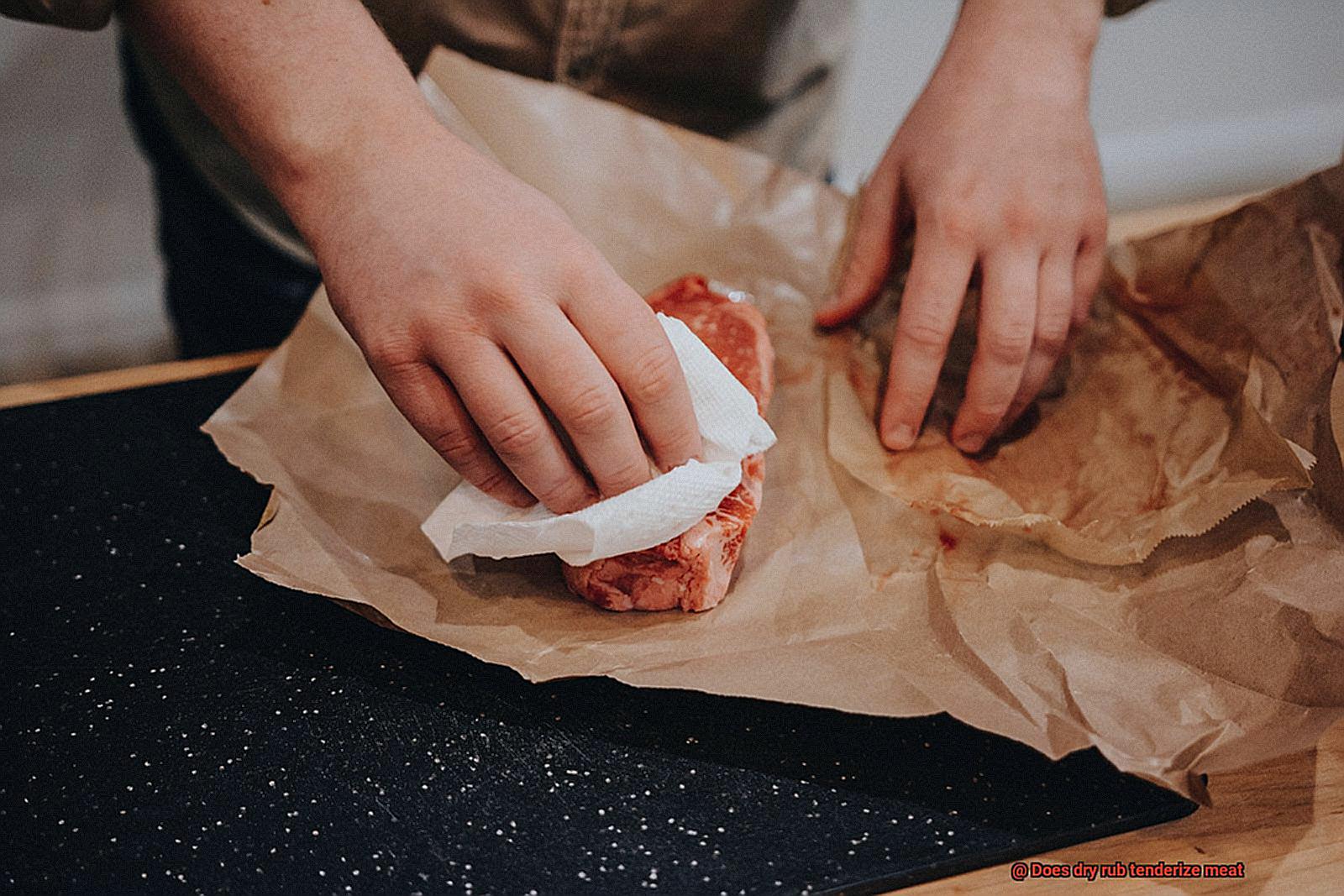
Curry-based Rubs
Curry-based rubs add an exotic twist to your grilled dishes. A blend of spices like cumin, coriander, turmeric, and ginger make up these rubs. They add depth of flavor that is sure to impress.
Cajun-based Rubs
Cajun-based rubs add a spicy kick to your meat. They usually contain cayenne pepper, paprika, garlic powder, and onion powder. These spices create a fiery blend that adds heat and complexity to any dish.
While dry rubs primarily add flavor to the meat, they can also help to tenderize it by drawing out moisture from the surface of the meat. It’s important to note that tenderizing meat requires other methods like marinating or using a meat tenderizer.
How to Apply a Dry Rub to Meat Properly
When it comes to grilling meat, applying a dry rub is an excellent way to enhance its flavor and texture. However, to achieve the best results, it’s important to know how to apply the dry rub correctly. Here are five sub-sections that will guide you on how to apply a dry rub to meat properly.
Choose the Right Rub
Choosing the right dry rub for your meat is crucial. Different meats pair well with different spices and seasonings, so take the time to select the perfect blend for your dish. For example, if you’re cooking chicken, a spice mix with rosemary and thyme may be ideal, while beef can benefit from a rub with garlic, onion, and black pepper.
Prepare the Meat
Before applying the dry rub, prepare your meat by washing it and patting it dry with paper towels. This step helps the rub adhere better to the meat’s surface.
Apply the Rub
Generously coat all sides of the meat with your chosen dry rub mixture. Using your hands to massage the rub into the meat ensures that it reaches every fold and crevice evenly. This step is critical as it enhances the flavor of the meat and creates a crust on its surface.
Let It Rest
After applying the dry rub, let your meat rest for at least 30 minutes before cooking. This time allows seasoning to penetrate deep into the fibers of the meat, enhancing its flavor and tenderness further. Some people prefer to let their meat sit overnight in the refrigerator with the dry rub on it for even more flavor and tenderness.
Grill or Smoke
When grilling or smoking your meat, make sure you cook it at an appropriate temperature and time recommended for that type of meat. The dry rub creates a flavorful crust on the exterior of the meat but won’t affect its tenderness. So, it’s essential to cook the meat correctly to achieve the desired tenderness.
Tips and Tricks for Getting the Most Out of Your Dry Rubs
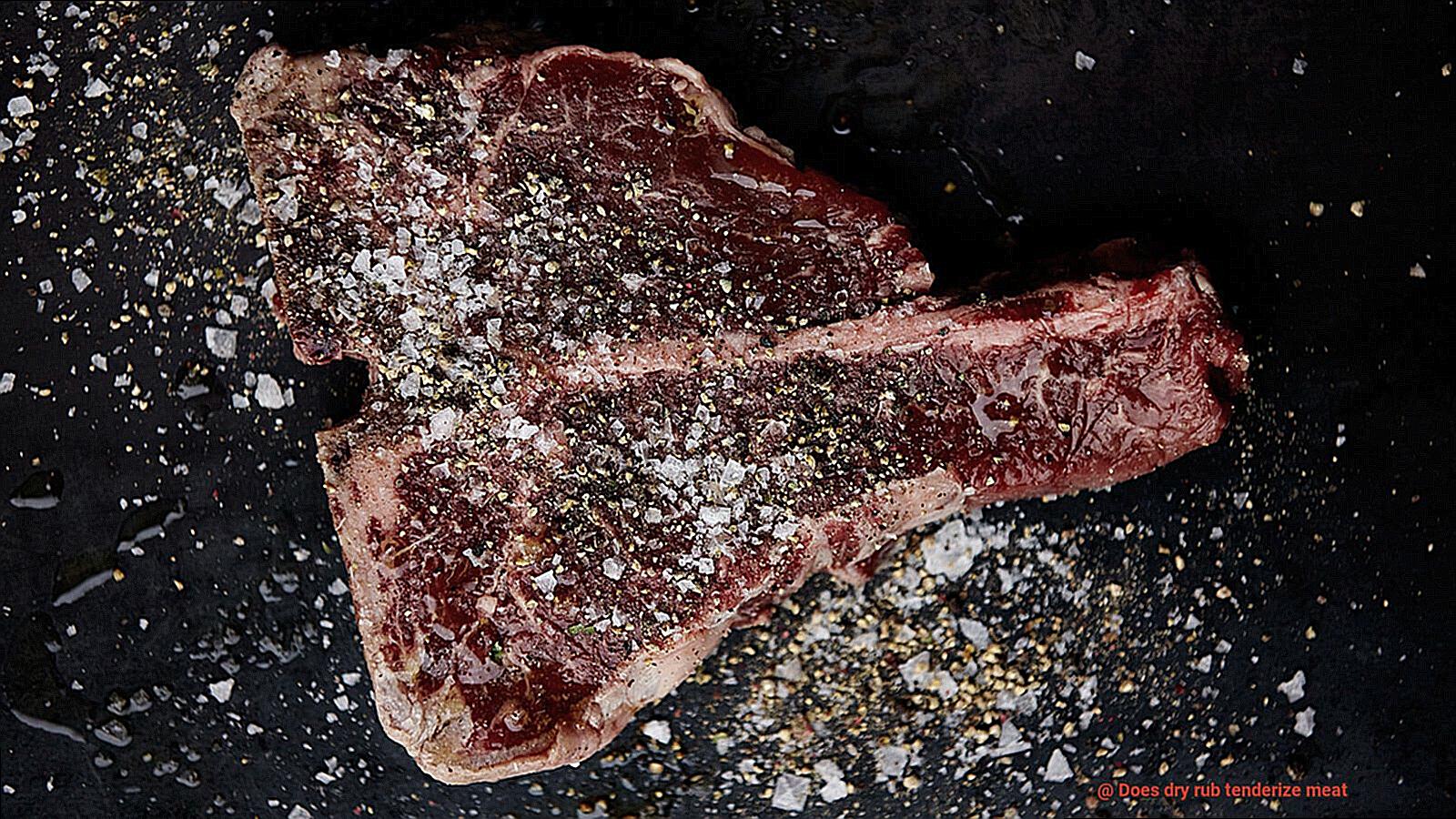
If you want to elevate your grilling game, dry rubs are a must-have. These mixtures of herbs, spices, and seasonings are applied to the surface of meat before cooking, creating a flavorful crust that will leave your taste buds dancing. While dry rubs themselves don’t tenderize meat, there are several tips and tricks you can use to get the most out of them. Here are five sub-sections to help you take your dry rub game to the next level.
Start with Quality Meat
The first step to getting the most out of your dry rub is starting with a high-quality cut of meat. Look for cuts with good marbling, which will already be more tender than lower-quality cuts. Additionally, make sure not to overcook the meat. Dry rubs can mask the flavor of overcooked meat, but they can’t make it tender again.
Use Acidic Ingredients
Acids like citrus juice or vinegar can help break down connective tissue in meat, making it more tender. However, be careful not to overdo it with acidic ingredients, as too much can actually toughen the meat. Pro tip: try using pineapple juice in your rub for a unique flavor profile that also helps tenderize the meat.
Apply the Rub Generously
Don’t be afraid to use plenty of rub on your meat. This will ensure that the flavor is evenly distributed and will result in a more flavorful end product. Be sure to massage the rub into the meat thoroughly, ensuring that it penetrates all of the nooks and crannies.
Cook Low and Slow
When cooking with a dry rub, it’s best to use a lower temperature and longer cooking time. This will allow the flavors to develop fully and ensure that the crust doesn’t burn. If you’re using a smoker, consider adding some wood chips or chunks for an extra depth of flavor.
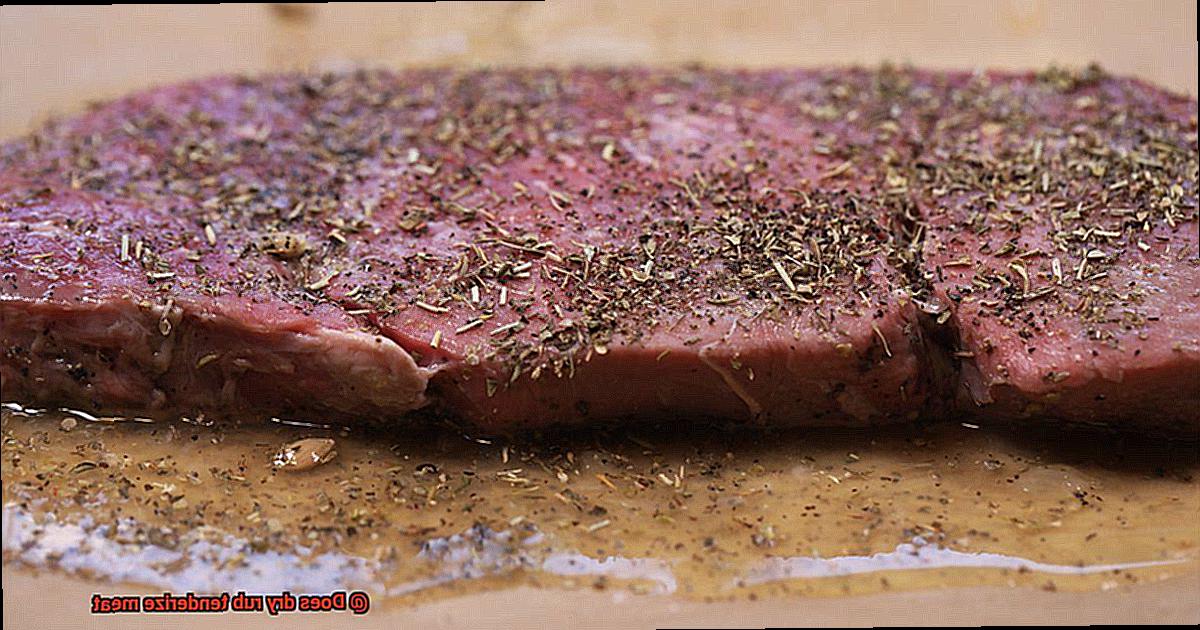
Experiment with Different Combinations of Spices and Herbs
While classic dry rub recipes exist, don’t be afraid to experiment with different combinations of spices and herbs to create your own unique blend. Just remember to balance out strong flavors with milder ones and taste as you go. Consider adding some smoked paprika or cumin for a smoky flavor, or rosemary and thyme for an earthy note.
Common Mistakes When Applying a Dry Rub
Before you get started, make sure you avoid these common mistakes that can affect the tenderness and flavor of your meat.
Firstly, don’t skimp on the rub. A dry rub not only adds flavor, but it also tenderizes the meat. Applying too little rub can result in tough and chewy meat. So, be generous when applying your rub and ensure every inch of the meat is covered.
Timing is everything when it comes to applying a dry rub. Applying it too early or too late can have negative effects. Applying it too early can draw out moisture from the meat, resulting in a dry texture. Conversely, if you apply it too late, the meat won’t have enough time to absorb the flavors and tenderizing properties of the rub. Aim to apply your rub a few hours before grilling or even overnight for maximum flavor and tenderness.
Using the wrong type of salt can be detrimental to the overall tenderness of your meat. Table salt can draw out moisture from the meat, resulting in a tougher texture. Instead, use kosher salt or sea salt, which will help to tenderize the meat while adding flavor.
Lastly, make sure you allow enough time for the rub to penetrate the meat fully. This means giving your meat enough time to sit with the rub on so it can fully absorb all those delicious flavors and tenderizing properties. Don’t rush this step – give it at least a few hours or even overnight for best results.
8Z1rInUG29E” >
Conclusion
In conclusion, dry rubs are a must-have for any grill master looking to elevate their meat game. Not only do they impart a rich flavor profile, but they also create a tantalizing crust on the surface of the meat when applied correctly. While dry rubs don’t technically tenderize meat on their own, they contain enzymes that can help break down connective tissues and make it more tender. Plus, the salt found in most dry rubs is excellent at drawing out moisture from the meat and breaking down tougher fibers.
To ensure maximum tenderness and flavor development, start with high-quality meat and use acidic ingredients like citrus juice or vinegar to help break down connective tissue. Don’t be shy with your application – generously coat and massage the rub into the meat to ensure even distribution. Low and slow cooking is key to achieving mouthwatering results.
When crafting your own dry rubs, consider using a combination of herbs and spices that complement the type of meat you’re seasoning. Experiment with different blends to create your own unique flavor profile while keeping in mind that balance is key.
Avoid common mistakes such as skimping on the rub or using table salt instead of kosher or sea salt. Allow enough time for your meat to absorb all those delicious flavors by letting it sit overnight if possible.

